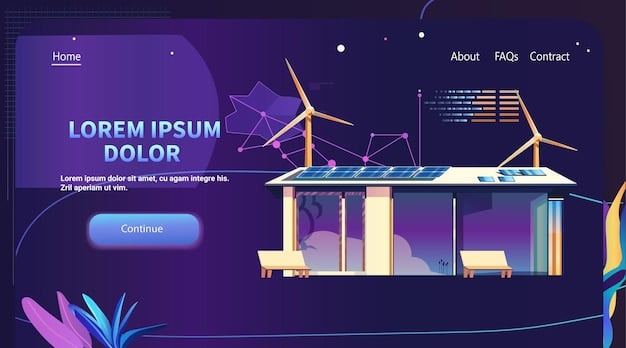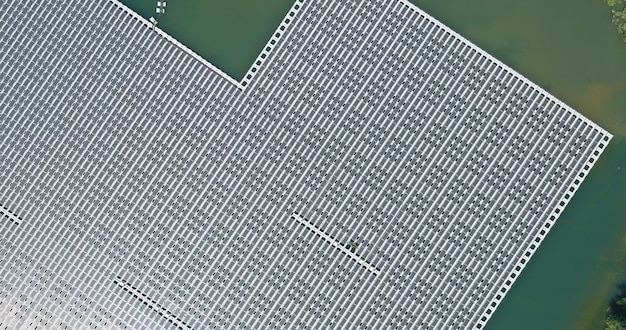IRA’s Impact on US Clean Tech Innovation: A Deep Dive

Advertisements
The Inflation Reduction Act (IRA) represents a monumental legislative leap, significantly accelerating and reshaping the landscape of clean technology innovation across the United States by providing unprecedented incentives and investments.
Advertisements
The landscape of clean energy and technology in the United States has long been a dynamic, evolving sector, brimming with potential yet often hindered by economic and policy uncertainties. However, a significant legislative milestone, The Impact of the Inflation Reduction Act on US Clean Tech Innovation, has emerged as a game-changer, fundamentally altering trajectories and fostering an environment ripe for unprecedented growth and groundbreaking advancements. This act isn’t merely a piece of legislation; it’s a strategic pivot designed to catalyze the transition to a greener economy, solidifying America’s position as a leader in global clean technology.
Understanding the Inflation Reduction Act’s Core Pillars
The Inflation Reduction Act (IRA), signed into law in August 2022, is far more than an environmental bill; it’s a comprehensive policy package that addresses climate change, healthcare costs, and tax reform simultaneously. Its climate and clean energy provisions, however, are unequivocally the most substantial federal investment in combating global warming in U.S. history. This foundational understanding is crucial for appreciating its profound ripple effects on clean technology innovation.
Advertisements
The IRA is built upon a framework of expansive tax credits, grants, and loan programs designed to incentivize domestic manufacturing, deployment, and research in clean energy. These incentives are not just about promoting renewable energy sources like solar and wind; they extend to a broad spectrum of technologies, including electric vehicles, battery storage, clean hydrogen, carbon capture, and energy efficiency upgrades. The strategic design of these mechanisms aims to create a predictable and long-term investment environment, a factor historically missing in the volatile clean energy sector. By offering credits over a decade, the IRA provides the certainty needed for companies to commit significant capital to new projects and manufacturing facilities within the United States. This stability encourages innovation by reducing the financial risk associated with developing and scaling novel technologies, ensuring that the country remains at the forefront of the global energy transition.
Long-Term Investment Certainty
The IRA’s commitment to providing long-term tax credits, often extending for ten years or more, marks a departure from previous, shorter-term policy cycles. This extended visibility is critically important for capital-intensive industries like clean energy, where project development cycles can span several years.
* Predictable Returns: Businesses can forecast returns on investment with greater accuracy.
* Reduced Risk: The certainty mitigates policy risk, making projects more attractive to investors.
* Strategic Planning: Companies can engage in multi-year planning for R&D and expansion.
Domestic Manufacturing Emphasis
A key feature of the IRA is its strong emphasis on domestic production. Many of the tax credits are “made in America” bonuses, meaning that projects using a certain percentage of domestically produced components receive enhanced benefits. This provision is designed to reshore manufacturing capabilities, create high-quality jobs, and strengthen supply chains within the United States, thereby reducing reliance on foreign sources for critical clean energy components. This strategic localization not only boosts economic activity but also shields the nascent clean tech industry from geopolitical supply chain vulnerabilities, ensuring a robust and self-reliant ecosystem for innovation.
The IRA’s core pillars are thus multifaceted, addressing economic, environmental, and strategic national interests. By understanding these foundational elements, we can better appreciate how the act is propelling the U.S. clean tech sector into a new era of expansion and innovation. The act’s comprehensive approach ensures that the benefits cascade through various segments of the economy, fostering a holistic growth in the clean energy ecosystem.
Accelerating Renewable Energy Deployment
The Inflation Reduction Act has unequivocally delivered a turbocharge to the deployment of renewable energy technologies across the United States. Prior to the IRA, while renewable adoption was growing, it often faced headwinds from inconsistent policy support and cost competitiveness issues compared to traditional fossil fuels. The act fundamentally shifts this dynamic by offering robust, long-term tax credits that make solar, wind, and geothermal power not just competitive, but often the most economically attractive options for new power generation.
The extension and enhancement of the Investment Tax Credit (ITC) and Production Tax Credit (PTC) for solar and wind projects, respectively, are central to this acceleration. These credits reduce the upfront costs of developing renewable energy projects, making them more feasible for a wider range of developers and investors. Furthermore, the IRA introduces new provisions, such as direct pay options for certain entities and transferability of credits, which broaden access to these incentives beyond traditional tax equity investors. This flexibility has significantly opened up the market, enabling more diverse participants—including non-profits, municipalities, and tribal governments—to invest in and benefit from renewable energy projects. The sheer scale and duration of these incentives provide an unprecedented level of market certainty, encouraging developers to plan and execute projects with confidence, pushing capacity additions to record levels.
Beyond the well-established solar and wind sectors, the IRA also extends significant support to emerging renewable energy technologies. Geothermal, hydropower, and sustainable biomass are now eligible for similar long-term tax credits, encouraging diversification within the clean energy portfolio. This comprehensive approach is vital for building a resilient and varied energy grid that can adapt to different geographical and resource availabilities. By incentivizing a wider array of clean energy sources, the IRA helps to de-risk investments in these less mature but equally vital technologies, fostering innovation not just in deployment but also in the underlying technological advancements required to scale them efficiently. This push for diversification creates new avenues for research and development, addressing unique challenges and optimizing energy solutions for specific regional needs.
The impact extends beyond utility-scale projects to distributed generation. Residential solar installations receive renewed tax credits, encouraging rooftop solar adoption among homeowners. This grassroots deployment plays a crucial role in decentralizing energy production, enhancing grid resilience, and empowering consumers to become active participants in the clean energy transition. The combination of utility-scale and distributed generation incentives creates a powerful synergy, ensuring that the U.S. is rapidly expanding its renewable energy capacity across all scales.
Boosting Domestic Manufacturing and Supply Chains
A cornerstone of the Inflation Reduction Act’s strategy is its explicit commitment to “Made in America” clean energy. For years, the U.S. clean tech industry has grappled with supply chain vulnerabilities, largely reliant on foreign manufacturing for critical components ranging from solar panels to electric vehicle batteries. The IRA directly addresses this by embedding robust domestic content requirements and manufacturing tax credits that incentivize companies to establish and expand their production facilities within the United States. This strategic pivot is designed not only to bolster economic security but also to foster a self-sufficient ecosystem for clean technology innovation, reducing geopolitical risks and creating high-quality American jobs.
The Advanced Manufacturing Production Credit (45X) is a pivotal mechanism within the IRA that provides specific incentives for the domestic production of key clean energy components. This credit covers a wide range of components, including solar components (modules, cells, wafers, polysilicon), wind components (blades, nacelles, towers), and battery components (electrodes, cells, modules, critical minerals). By offering per-unit credits, the IRA significantly reduces the cost of manufacturing these items domestically, making U.S. production competitive with, and often more attractive than, overseas alternatives. This economic advantage is already catalyzing a wave of announcements for new manufacturing plants and expansions across the country, signaling a clear shift in global supply chains as companies seek to capitalize on these substantial incentives. For instance, major battery manufacturers and solar panel producers are investing billions in new U.S. facilities, demonstrating a tangible shift in strategy influenced by the IRA’s provisions.
Key Components and Incentives
* Solar Energy: Credits for polysilicon, wafers, cells, and modules encourage comprehensive domestic production of solar panels.
* Wind Energy: Incentives for blades, nacelles, and towers are driving new wind turbine manufacturing plants.
* Batteries: Critical mineral processing, battery cell production, and module assembly are heavily subsidized to build a domestic EV battery supply chain.
* Heat Pumps & Electrolyzers: Specific credits for the manufacturing of these components further diversify the clean tech industrial base.
The IRA also provides tax credits that reward projects that use domestically manufactured components (e.g., the 10% bonus for renewable energy projects that meet domestic content thresholds). This dual approach—incentivizing both component manufacturing and project development with domestic content—creates a powerful feedback loop. As more domestic manufacturing capacity comes online, it becomes easier for projects to meet the domestic content requirements and qualify for additional incentives, further driving demand for U.S.-made clean energy products. This virtuous cycle strengthens the entire domestic clean tech supply chain, from raw material extraction and processing to assembly and deployment. The long-term implication is a more resilient, robust, and innovative clean tech sector, less susceptible to global supply chain disruptions and better positioned to drive future technological advancements.

Innovations in Electric Vehicles and Charging Infrastructure
The Inflation Reduction Act introduces a transformative suite of incentives aimed at supercharging the adoption and domestic manufacturing of electric vehicles (EVs) and bolstering crucial charging infrastructure. Historically, the transition to EVs faced hurdles such as high upfront costs, limited model availability, and a nascent public charging network. The IRA directly confronts these challenges by restructuring existing tax credits and introducing new ones, catalyzing both consumer demand and industry-wide innovation. This legislative push is designed to accelerate America’s leadership in the global EV market, creating a robust domestic supply chain from battery minerals to finished vehicles.
For consumers, the IRA revamped the clean vehicle tax credit, offering up to $7,500 for new vehicles and a new $4,000 credit for used EVs. Crucially, these credits are tied to stringent domestic manufacturing and sourcing requirements for batteries and critical minerals. This dual objective ensures that as EV adoption grows, the economic benefits and jobs remain within the United States. The “made in America” stipulation for batteries and vehicle assembly is a powerful incentive for automakers to reconfigure their supply chains, fostering significant investments in domestic battery gigafactories and EV production lines. This re-localization not only bolsters American manufacturing but also accelerates innovation in battery chemistry, energy density, and charging speeds, as companies compete to meet rising demand and enhanced performance expectations.
Key EV and Charging Incentives
* New Clean Vehicle Credit ($7,500): Incentivizes purchase of new EVs meeting domestic content and battery sourcing rules.
* Used Clean Vehicle Credit ($4,000): Encourages a robust secondary market for EVs, making them more accessible.
* Commercial Clean Vehicle Credit: Supports fleets transitioning to EVs, reducing emissions from commercial transportation.
* Alternative Fuel Vehicle Refueling Property Credit: Direct support for the expansion of EV charging infrastructure.
Beyond vehicle purchases, the IRA provides significant tax credits for the deployment of EV charging infrastructure. The Alternative Fuel Vehicle Refueling Property Credit offers a 30% tax credit (up to $100,000) for qualified charging projects. This incentive is critical for building out a comprehensive, reliable, and accessible charging network across the country, addressing a major concern for potential EV buyers. As more charging stations become available, range anxiety diminishes, further propelling EV adoption. This investment also stimulates innovation in charging technology itself, from faster charging speeds and smarter allocation systems to vehicle-to-grid (V2G) capabilities, which could allow EVs to act as distributed energy storage. By creating a symbiotic relationship between consumers, manufacturers, and infrastructure developers, the IRA is paving the way for a rapid and broad-scale transition to electric mobility. The combined effect of these provisions is a vibrant ecosystem where innovation flourishes at every level, from advanced battery materials to seamless charging experiences, cementing the U.S. as a powerhouse in the global EV revolution.
Advancing Critical Technologies: Hydrogen and Carbon Capture
The Inflation Reduction Act extends its transformative reach beyond traditional renewable energy sources to embrace pivotal, next-generation clean technologies, specifically clean hydrogen and carbon capture, utilization, and storage (CCUS). These technologies are considered essential for decarbonizing hard-to-abate sectors such as heavy industry, long-haul transportation, and dispatchable power generation, where electrification alone may not be sufficient. By providing substantial, long-term financial incentives, the IRA aims to accelerate the commercial scale-up and widespread deployment of these nascent but critical solutions, thereby unlocking new pathways to achieving ambitious climate goals.
The Clean Hydrogen Production Tax Credit (45V) is a game-changer for the nascent hydrogen industry. It offers up to $3.00 per kilogram for hydrogen produced with ultralow greenhouse gas emissions, significantly reducing the cost of clean hydrogen production (e.g., green hydrogen produced via electrolysis using renewable electricity, or blue hydrogen with effective carbon capture). This credit is designed to bridge the economic gap between clean hydrogen and traditional, fossil fuel-derived hydrogen, making it competitive for industrial applications as a feedstock, fuel, or energy carrier. The long-term certainty of this credit (up to 10 years for new facilities) encourages massive investments in electrolyzer manufacturing, renewable energy projects dedicated to hydrogen production, and the development of associated infrastructure like pipelines and storage. This creates a fertile ground for innovation in electrolysis technologies, hydrogen storage solutions, and new applications for hydrogen across diverse sectors.
High-Impact Technologies
* Clean Hydrogen: Essential for decarbonizing heavy industry, transportation, and power. The 45V credit makes low-carbon production economically viable.
* Carbon Capture, Utilization, and Storage (CCUS): Crucial for addressing emissions from difficult-to-abate sectors and for direct air capture. The 45Q credit provides enhanced incentives.
Similarly, the IRA significantly enhances the Section 45Q tax credit for carbon capture, utilization, and storage. The credit values per metric ton of captured CO2 have been dramatically increased: from $50 to $85 per metric ton for direct air capture and from $35 to $60 for industrial capture and power generation. This boost makes CCUS projects much more economically attractive, encouraging power plants, industrial facilities, and direct air capture companies to invest in this technology. By making CCUS more financially viable, the IRA stimulates innovation in carbon capture materials and processes, CO2 transport and storage infrastructure, and novel utilization pathways for captured carbon (e.g., converting CO2 into fuels, chemicals, or building materials). The combined effect of these incentives for clean hydrogen and CCUS is the acceleration of technologies previously considered too expensive or niche to deploy at scale, opening up new frontiers in the battle against climate change and establishing the U.S. as a leader in these complex technological solutions.
Fostering Energy Efficiency and Grid Modernization
Beyond the buzz of solar panels and electric vehicles, a crucial, yet often less visible, area where the Inflation Reduction Act makes a profound impact is in fostering energy efficiency and catalyzing grid modernization. A robust and resilient electricity grid, coupled with widespread energy efficiency improvements, forms the backbone of a successful clean energy transition. The IRA recognizes this by allocating significant resources to upgrade aging infrastructure, reduce energy waste in homes and businesses, and integrate an ever-increasing supply of renewable power. These investments are critical for ensuring that the clean energy generated can be effectively transmitted, distributed, and utilized, maximizing its environmental and economic benefits.
The Act introduces a suite of incentives designed to make homes and buildings more energy-efficient. For homeowners, expanded tax credits (25C and 25D) cover investments in energy-efficient home improvements, such as heat pumps, advanced windows, insulation, and efficient HVAC systems. The new Home Energy Rebates (HEER) program provides upfront rebates for energy-saving upgrades, making efficiency accessible to a broader range of income levels. These direct financial benefits encourage widespread adoption of energy-saving technologies, leading to reduced energy consumption, lower utility bills, and decreased carbon emissions from the residential and commercial sectors. This also stimulates innovation in smart home technologies, building materials, and energy management systems that optimize consumption and integrate seamlessly with a decarbonizing grid.
Key Efficiency and Grid Enhancements
* Residential Energy Credits: Incentives for heat pumps, solar, efficient windows, and insulation to reduce household energy consumption.
* Commercial Building Rebates: Programs to promote energy-saving upgrades in commercial and multi-family structures.
* Grid Modernization: Funding for smart grid technologies, transmission line upgrades, and energy storage to enhance grid resilience and reliability.
Furthermore, the IRA makes substantial investments in modernizing the nation’s electricity grid. As more intermittent renewable energy sources (like solar and wind) come online, the grid needs to become smarter, more flexible, and more resilient. The act provides funding and tax credits for large-scale energy storage projects (e.g., grid-scale batteries), smart meter deployment, transmission line upgrades, and advanced grid technologies that can balance supply and demand more effectively. These investments are critical for integrating renewables efficiently, preventing blackouts, and enabling the seamless flow of clean power across states. By prioritizing grid modernization, the IRA ensures that the rapid deployment of clean energy is matched by an infrastructure capable of handling and optimizing it, laying the groundwork for a truly decarbonized and resilient energy future. The focus on energy storage, in particular, is fostering significant innovation in battery technology, flow batteries, and other energy storage solutions, which are vital for grid stability and reliability.

Economic and Job Creation Spillovers
The Inflation Reduction Act’s impact extends far beyond environmental benefits and technological advancements; it is poised to generate significant economic and job creation spillovers across the United States. By incentivizing domestic manufacturing, fostering new industries, and driving demand for clean energy technologies, the IRA is designed to stimulate economic growth, create a new wave of high-paying jobs, and strengthen America’s competitive position in the global clean economy. This economic dividend is a crucial aspect of the IRA’s appeal, promising tangible benefits for communities and workers nationwide.
A direct consequence of the IRA’s “Made in America” provisions and manufacturing tax credits is a surge in investment in new factories and production lines. Companies are announcing multi-billion dollar commitments to build solar panel factories, battery gigafactories, wind turbine component plants, and facilities for clean hydrogen and carbon capture equipment. These investments translate into thousands of construction jobs, followed by stable, long-term manufacturing jobs. The creation of these jobs is often concentrated in regions that previously experienced economic decline due to the retreat of traditional industries, offering a pathway to revitalization through clean energy. Furthermore, these aren’t just assembly jobs; they encompass skilled labor in engineering, research and development, quality control, and advanced manufacturing techniques, requiring and fostering a highly trained workforce.
IRA’s Economic ripple effects
* Manufacturing Boom: New factories for solar, wind, batteries, and EVs creating thousands of jobs.
* Supply Chain Growth: Expansion in raw material extraction, processing, and component manufacturing.
* Service Sector Expansion: Growth in installation, maintenance, project development, and associated professional services.
* Research and Development: Increased investment in clean tech R&D, fostering innovation and high-tech jobs.
Beyond direct manufacturing, the IRA stimulates job growth across the entire clean energy supply chain and service sector. The deployment of solar panels and wind turbines requires skilled installers, electricians, and maintenance technicians. The expansion of EV charging infrastructure necessitates more construction workers and service personnel. New industries, such as clean hydrogen production and carbon capture, will require specialized engineers, operators, and scientists. Moreover, the increased demand for clean technologies drives innovation in research and development, leading to the creation of high-tech jobs in laboratories, universities, and corporate R&D centers. The economic spillovers also include indirect job creation in sectors that support the clean energy industry, such as logistics, finance, and professional services. This comprehensive economic impact transforms the clean energy transition into a powerful engine for broad-based economic prosperity, positioning the U.S. at the forefront of the global clean technology revolution. The long-term nature of the IRA’s incentives provides stability, allowing businesses and workers to plan for a sustained period of growth and development within the burgeoning clean tech sector.
| Key Aspect | Brief Impact Description |
|---|---|
| ☀️ Renewable Energy Acceleration | Long-term tax credits for solar and wind boost deployment and market certainty. |
| 🚗 EV & Charging Innovation | Consumer credits and infrastructure funding drive domestic EV manufacturing & network expansion. |
| 🏭 Domestic Manufacturing Boost | Incentives for US-made components strengthen clean tech supply chains. |
| 💡 Next-Gen Tech Adoption | Significant support for clean hydrogen and carbon capture scale-up. |
Frequently Asked Questions
▼
The primary goal of the IRA concerning clean technology is to accelerate the transition to a clean energy economy in the United States. It aims to achieve this by providing unprecedented financial incentives, such as tax credits and grants, to encourage domestic manufacturing, deployment, and innovation across various renewable energy sources, electric vehicles, and other emissions-reducing technologies. This comprehensive approach seeks to lower carbon emissions significantly while simultaneously creating economic opportunities and strengthening energy independence.
▼
The IRA significantly boosts domestic clean energy manufacturing through mechanisms like the Advanced Manufacturing Production Credit (45X) and domestic content bonuses for projects. These incentives provide per-unit tax credits for components like solar cells and modules, wind blades, and battery components manufactured in the U.S. This makes domestic production more cost-competitive, encouraging companies to invest in new American factories and bolstering the national clean technology supply chain. The goal is to reduce reliance on foreign imports for critical clean energy technologies.
▼
For EVs, the IRA revamped consumer tax credits, offering up to $7,500 for new vehicles, with conditions tied to domestic manufacturing and battery sourcing. This encourages consumers to buy EVs while also pushing automakers to localize their supply chains within the U.S. Additionally, the act provides substantial tax credits for the deployment of EV charging infrastructure (Alternative Fuel Vehicle Refueling Property Credit), aiming to build a robust and accessible national charging network, thereby alleviating range anxiety and further accelerating EV adoption.
▼
Yes, the IRA provides significant support for emerging and critical clean technologies beyond traditional solar and wind. It introduces the Clean Hydrogen Production Tax Credit (45V), offering substantial incentives for low-carbon hydrogen production. Furthermore, it enhances the Section 45Q tax credit for carbon capture, utilization, and storage (CCUS), making these projects more economically viable. These provisions are crucial for decarbonizing hard-to-abate sectors of the economy where electrification alone is not sufficient, fostering innovation and deployment in these complex areas.
▼
The IRA significantly contributes to job creation by incentivizing domestic manufacturing, deploying renewable energy projects, and upgrading infrastructure. The influx of investments into new factories for solar, wind, and EV components directly creates thousands of construction and long-term manufacturing jobs. Additionally, the widespread deployment of clean energy technologies generates demand for skilled installers, maintenance technicians, and engineers. This comprehensive approach promotes economic growth across the entire clean tech supply chain, stimulating both direct and indirect job creation across various sectors.
Conclusion
The Inflation Reduction Act has unequivocally set a new trajectory for clean technology innovation and deployment in the United States. From boosting renewable energy proliferation and supercharging the electric vehicle market to fostering domestic manufacturing and advancing critical frontier technologies like clean hydrogen and carbon capture, the IRA represents a strategic commitment to a sustainable and economically robust future. Its long-term, predictable incentives are not merely driving adoption but are fundamentally reshaping supply chains, creating myriad jobs, and positioning the U.S. as a global leader in the green economy. While challenges remain in fully realizing its potential, the comprehensive framework established by the IRA ensures a dynamic and innovative landscape for clean tech for years to come, offering a compelling vision of a cleaner, more resilient America.





